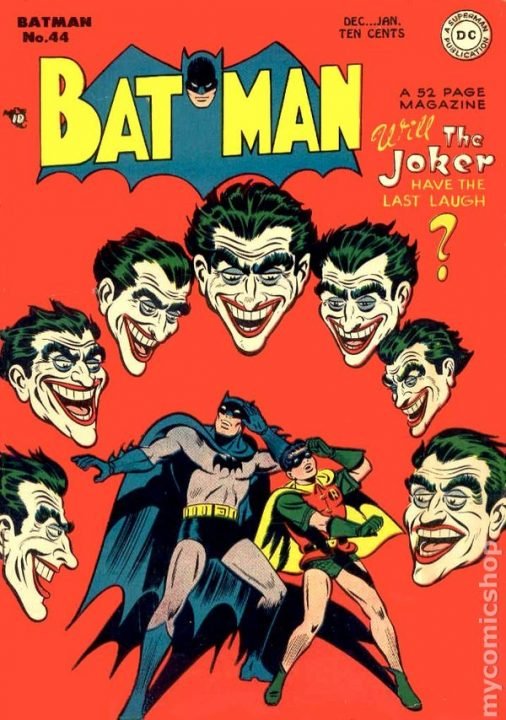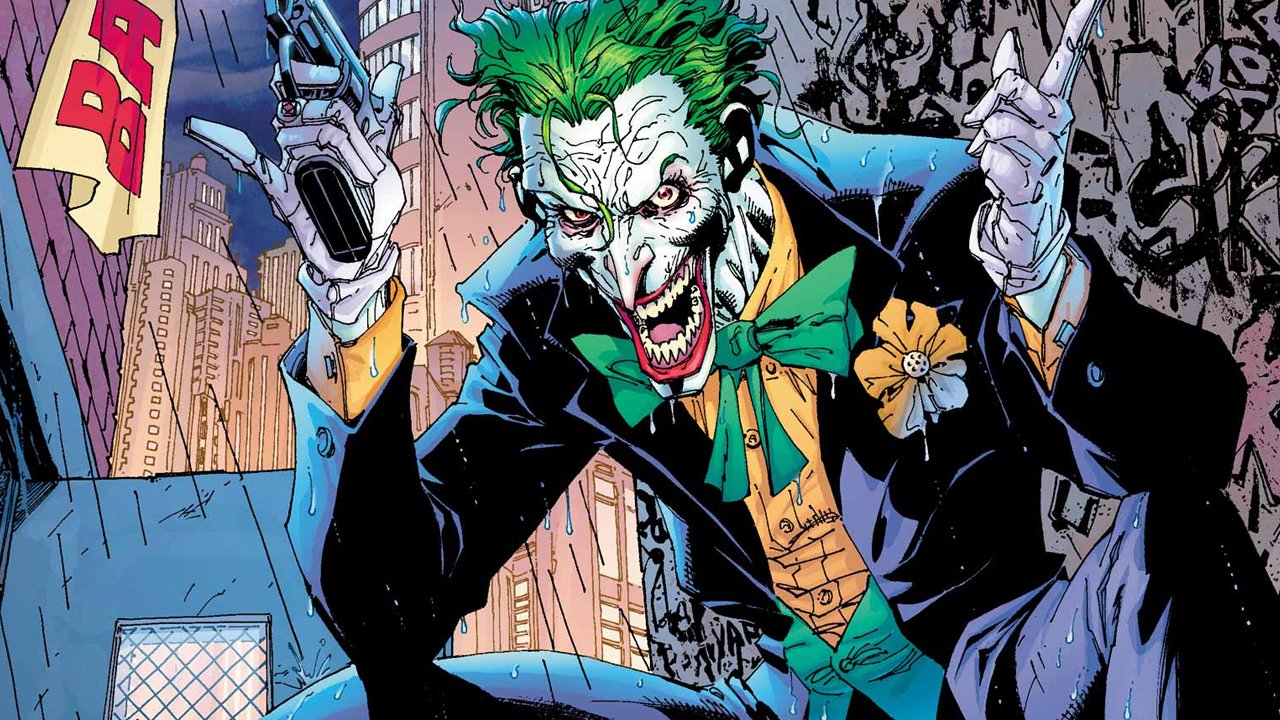The Joker is arguably the most iconic comic book villain of all time. He has cemented himself in popular culture through comics, TV shows and movies. Even non-comic book junkies know the Joker—his trademark smile, his sadistic laugh. In short, he’s the best of the worst. But how did he get there? Was he always the incarnation the world sees today, or was there an evolution? For the Joker, there has been a history of madness; one that has seen change throughout the decades, mirroring societal shifts with each incarnation.

The Joker came on the comic scene in Batman #1 in 1940. In his first issue, readers were treated to a maniacal madman with super strong links to the Joker we know and love today. This Joker killed and left his victims with creepy smiles stretched across their faces. While the stories from this era lack the depth and sophistication of today’s works, Batman #1 introduced a Joker who was a holy terror to the people of Gotham.
At this time in American history, the world was engaged in war. While the US was a year and a bit away from entering the global conflict, American society wasn’t immune to the newsreels and the imminent threats of the Axis powers. The sinister, psychotic edge to the Joker’s beginnings reflected those threatening times. However, once WWII was over, and the Joker made his way into the 1950s, things began to change.
Looking at American popular culture in the 50’s, TV series like Leave It To Beaver and I Love Lucy were becoming the fabric of society. Wholesome had won out over bloodshed and middle class values were on the rise. To survive, the Joker needed to adapt. During the 50s, Batman comics involving the Joker became quite campy. He bounded high atop a trapeze dressed as a circus clown, drove around in a car with his face plastered on the side, and became more of a mastermind, engineering flamboyant schemes Batman would need to foil instead of remaining the crazed killer as was originally introduced in the early issues. In short, the Joker had changed.

By the 1960s, the Joker was largely tamed. This was never more evident than when he entered popular culture in the TV series Batman, which ran from 1966-68. Cesar Romero played the Clown Prince of Crime as the comic book version that was hitting stands: one full of loud laughter and goofy pranks. For that time, the Joker worked. The TV series became a cult classic and brought not only Batman but also his rogue’s gallery into popular culture. Whether a fan of Batman or not, most people can hum a few bars of the opening musical number of the TV series. So it wasn’t until the 1970s when the Joker finally returned to his murderous and psychotic roots.

Artists like Neal Adams and writers like Denny O’Neil and Steve Englehart brought the Joker from the campy 60s into the grit and grime of the 70s. Dark and violent films like The French Connection, The Godfather, and Taxi Driver were challenging the old guard of popular culture and Batman comics began to reflect that edginess. As a result, the Joker followed suit. In Batman #251—titled The Joker’s Five Way Revenge—the Joker was back to his old ways of killing his victims and leaving them with a deadly grin. In 1978, a now classic two-issue story titled The Laughing Fish continued to showcase the Joker in that murderous way, this time finding the Joker poisoning the fish in Gotham Harbor. Here, DC writer Steve Englehart painted the Joker not as a slightly mad court jester, but a serious villain for a serious time. Yet even with these giant leaps forward, the Joker needed to push the boundaries again. And further he would go when the 1980s arrived.
It all began with a single graphic novel, one that showed the real dark side of Gotham and opened the doors for so many Batman stories fans now love and cherish. In 1985, DC released Frank Miller’s The Dark Knight Returns. Although the story wasn’t focused on Batman and the Joker exclusively, it did end with a shocking conclusion—a fight to the death between the Dark Knight and the Harlequin of Hate. Miller’s graphic novel took Batman to new heights and proved that this darkened DC could be a major seller. A few years later, in 1988, Alan Moore took Batman and the Joker to the ultimate lows in the greatest of ways. The Killing Joke was a Joker story that sent shock waves through the comic book community. Where The Dark Knight Returns was a game changer for Batman, The Killing Joke did the same for the Joker. Moore took the Joker for who he truly is: a homicidal psychopath with no regard to human decency. One who would use all his enemies as toys in his games of madness. Within that same year, the Joker was at it again, this time in A Death in the Family. The four part miniseries put the Joker right in the middle of another ground breaking storyline. This was no longer your father’s Joker.

Oddly enough, while the comic world had fully embraced the Joker as a homicidal maniac capable of the most heinous crimes, in film and television, he wasn’t quite there. In 1989, Tim Burton released his take on the Dark Knight, Batman, with the Joker being played by Hollywood’s own court jester Jack Nicholson. The movie was a triumph, making hundreds of millions at the box office, but its portrayal of the Ace of Knaves didn’t reflect the comics. Nicholson’s Joker was a step up from the 60’s TV series, but he was still far from being fully unleashed. On the small screen, the Joker resembled that tamed caricature. Batman: The Animated Series followed the film several years later, and while Mark Hamill’s voice performance of the Joker was fantastic and playful, offering hints of homicidal madness, this was a cartoon for both children and adults. How far could they really go?
Fans of the Joker would have to wait almost 20 years before they saw a Clown Prince of Crime on the silver screen that resembled his reign of terror in the comics. In 2008, their dream would come true.

Christopher Nolan’s The Dark Knight masterfully presented the Joker as an anarchist. A villain capable of all that The Killing Joke and A Death in the Family offered. Heath Ledger’s portrayal was so laser sharp he won a posthumous Oscar. The public was finally ready for this Joker, the comic book community’s Joker. In a post 911 world where terrorism was a real threat, Ledger’s Joker embodied society’s fears. This Joker was madman who, as Alfred so poignantly put it, wanted to watch the world burn. Finally, the Joker had been shown to the masses in all his homicidal glory and, thus, was accepted into the fabric of popular culture.
The Joker has been in Batman stories for over 75 years and he will once again be put into the forefront with the release of Suicide Squad this summer. Director David Ayer and actor Jared Leto (who will be playing the Joker) have made the risky but necessary choice of showing audiences a version of the Joker no one has seen before on the big screen. Short hair, a body riddled with tattoos, a grill on his teeth and bare foot to boot. The Joker’s shoes are enormous to fill—the size of an Academy Award to be exact. But that’s the way of the Joker. He’ll continue to be reinvented to reflect society, as he has been doing throughout his fictional 75 plus years.



